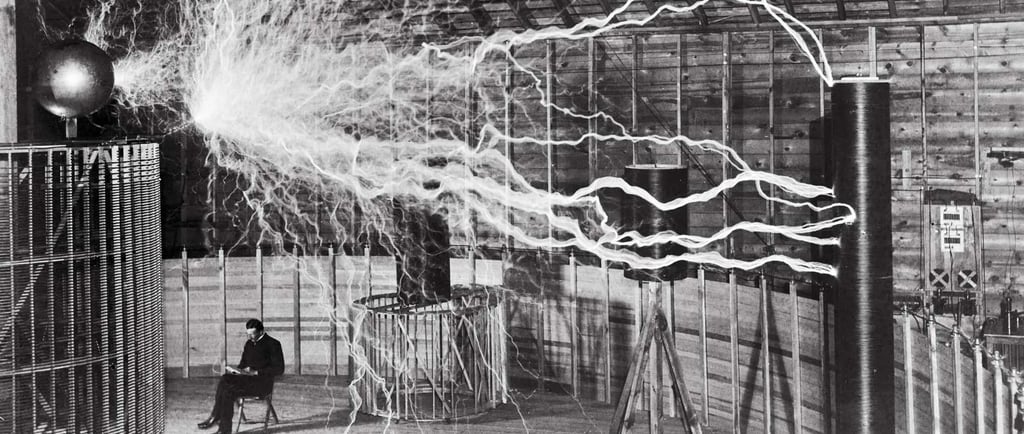Think Like a Genius: A Practical Guide to Nikola Tesla’s Mental Model
This is my efforts into reverse-engineering Nikola Tesla's mind. If this can be applied into our lives, I expect an astronomical change in humanity's advancements in Science and Technology.
Ian Patel
9/1/20252 min read


Imagine sitting calmly in a room while millions of volts of electricity crackle and arc around you. That was Nikola Tesla in 1899, at his Colorado Springs laboratory. To him, it wasn’t just spectacle—it was a glimpse into how his mind worked. Tesla, the architect of much of our modern electrical world, possessed a unique “mental model” that allowed him to invent, test, and refine entire systems inside his imagination before ever building them.
The good news? Tesla’s method wasn’t magic. It was a disciplined process anyone can adapt to boost creativity, solve complex problems, and unlock genius-level thinking.
The Architecture of Genius: Tesla’s Three Mental Pillars
Tesla’s brilliance rested on three interconnected pillars. Together, they formed the foundation of his “mental laboratory.”
1. The Mental Laboratory (Masterful Visualization)
Tesla could build complete inventions in his mind—detailed, full-scale prototypes he could run, tweak, and test mentally. He could spot flaws, watch components wear out, and refine designs weeks before ever touching a tool.
2. Systems Thinking (Seeing the Interconnected Whole)
Where others focused on individual devices, Tesla envisioned entire ecosystems. His alternating current (AC) system wasn’t just a motor—it was an integrated network for generating, transmitting, and distributing power to electrify the world.
3. Divergent-Convergent Thinking (Creative-Analytical Balance)
Tesla’s genius came from balancing bold imagination with precise refinement. First, he explored limitless possibilities. Then, he tested rigorously in his mental lab, discarding weak ideas and polishing the strong ones.
The Tesla Method: A 5-Stage Framework for Modern Innovators
Tesla’s thinking can be translated into a five-step process anyone can use to innovate more effectively.
Stage 1: Mental Preparation (Solitude & Focus)
Tesla thrived on solitude. He followed strict routines, worked with intensity, and walked miles daily to fuel his mental energy. Solitude and structure gave him the clarity to think at the highest level.
Stage 2: Problem Visualization (Mental Construction)
Start by clearly defining your challenge. Then, build the solution in your mind. Visualize it in detail—down to how it looks, sounds, and feels.
Stage 3: Mental Simulation (Testing & Refinement)
Run your mental model. Imagine it in operation over time. Stress-test it under extreme conditions. Identify weaknesses, refine, and rerun until it holds up.
Stage 4: Systems Integration (The Holistic View)
Zoom out. How does your solution connect with the bigger picture? Consider stakeholders, scalability, and how it integrates into the broader ecosystem.
Stage 5: Physical Implementation (Bringing Vision to Reality)
Only after perfecting his designs mentally did Tesla build physical prototypes. For him, this final step was about confirmation, not experimentation—saving time, effort, and resources.
Applying Tesla’s Thinking Today
Tesla’s approach isn’t limited to inventors. Anyone can apply it:
Entrepreneurs: Run your entire business model in your head before launch. Design for the ecosystem, not just the product.
Students: Visualize concepts, rehearse presentations, and solve problems mentally. This builds real-world competence.
Creatives: Imagine the finished work fully before producing it. Experiment mentally, then commit to the best version.
Key Takeaways: Your Path to Thinking Like Tesla
Visualization is trainable. Start with small mental exercises and build clarity over time.
Solitude fuels creativity. Disconnect to access your deepest insights.
Structure creates freedom. Routines free mental bandwidth for meaningful work.
Think in systems. Solutions that integrate with larger contexts create revolutions, not novelties.
Test mentally, build physically. Save resources by refining ideas in imagination before execution.
Tesla’s true legacy isn’t just in his inventions—it’s in his process. He showed that genius can be cultivated through disciplined mental practices. By adopting his framework, you can move beyond ordinary problem-solving and begin crafting truly transformative ideas in the laboratory of your own mind.